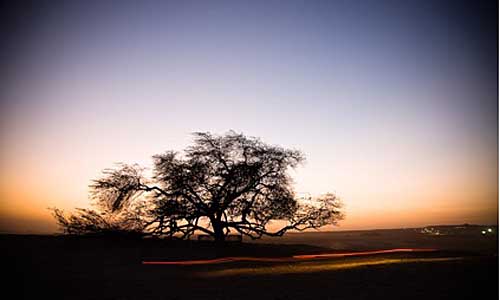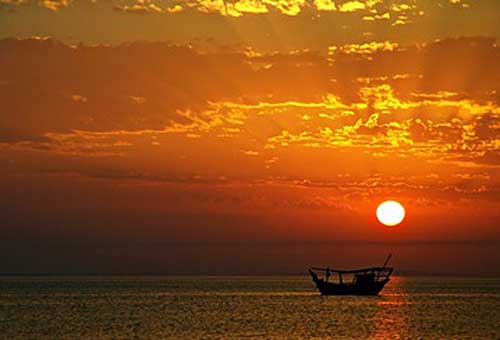This is the second installment in a four part series. Read the first here.

Photo by Pamela Roberson
Just at sunset we reach The Tree of Life, a 400-year-old acacia perched on an abrupt hillock, the only visible piece of life in all directions. It is impressive. Thirty-feet high, with branches spreading almost seventy-five feet across, though on closer inspection, a bit disappointing to see trash strewn around its base, the result of visiting journalists, I'm told. Hakkim says this is the most popular site for foreign news-people, and that he has trekked to this remote site so many times he is tempted to uproot the old tree and move it closer to the capital.
The morning next we drive to the Marina Club on the edge of Manama, a city whose name means "the place of sleeping." There we board a sort of super-dhow, an elegant 36-foot long diesel-powered barge modeled after a Portuguese caravel. The boat is named Shamsan ("Two Suns"), and built for the government-owned Tourism Projects Company. We chug for 90 minutes, dolphins leaping at our sides, black-headed gulls above our stern, on out through a dredged channel, past several U.S. warships, to...the Falkland Islands. They are actually a set of three man-made islets called Al Dharr, created as a tourism project around the time of the Argentine-British conflict, and somehow the motes took on the topical nickname. A story is making the rounds that a fisherman hit a rock in a storm recently, and started to sink. He issued a Mayday signal on the radio, and picked up a British frigate somewhere nearby in the Gulf. When the British officer asked for the location of the accident, the fisherman said the Falklands; the Brit said he was sorry, but he couldn't help with such a distant problem, and hung up.
A gentle sea breeze stirs the tiny islands. Not much bigger than baseball diamonds in the turquoise shallows of the Gulf, they are dotted with umbrellas made with date palm fronds, a small snack bar, and a fort-like tower, the bathroom. About a dozen off-duty allied soldiers are lounging on the beach, another dozen in the warm, clear water, while a barbecue is being prepared by the crew of their dhow. Beyond the shimmering blue-green sea is a skyline of refineries and a desalination plant in one direction, and U.S. Navy warships in the other. Not exactly Bali.
Bahrain hosts the U.S. Navy's Middle East Force, the only U.S. military facility in the Gulf. It was just northeast of here that the guided-missile frigate Stark was hit by an Iraqi missile in 1987, and then repaired in Bahrain's dry dock. Still, the Falklands have promise, something like Green Island off the coast of Cairns in Australia, a day picnic trip to a desert island featuring swimming, snacks and sharks among the 73 varieties of coral and as many tropical fish. Whales, rare green sea turtles, and hawksbill turtles also ply these aquamarine waters, along with nine species of sea snakes, some lethal. The sea here is also a favorite habitat of the gentle dugong, or sea cow. The rare, walrus-sized mammal, a first cousin of the American manatee, is so shy and whimsical that ancient sailors often mistook it for a mermaid as it rose from the depths wearing a wig of sea grass. A recent aerial survey discovered the largest single concentration of the animals in the world--a bloat numbering almost seven hundred.
Back on the main island we visit a dhow boatyard, to see how the craft is constructed, hand-hewn from teak imported from India. Dhow building peaked in the early part of the 20th century, when the pearl fleets, often more than 5000 boats, set sail for the oyster beds in June and returned in October. Business dropped radically with the collapse of the industry in the 30s, but dhows were still purchased as fishing vessels and for trade and transport to Saudi Arabia. The latter market disintegrated when the 1.2 billion dollar, 15-mile-long King Fahd Causeway opened in November, 1986, which at that point was the largest single construction job in the history of the Gulf, and the most expensive bridge in the world. It stretches from the mainland like an arm reaching for a pearl, and it is now an hour drive from the crude Saudi city of Dhahran to the bars and beaches of Bahrain. Many of the old boat builders have lowered their sights and now make a living building models for sale to tourists. In a room near the boatyard I find a craftsman sawing away at a tiny lateen sail for a model dhow. Just as in crafting the big versions, the artist uses no plans or power tools, and he has memorized all the measurements and proportions. For inspiration, on his walls are a number of posters, of Rambo, Arnold Schwarzenegger in Commando, and one poster showing a stealth fighter leaving Langley Air Force base for the 15-hour flight to the Gulf, with the legend, "In Slickness and in Stealth."

Photo by Pamela Roberson
The following day I awake early and suit up to take a run along a strip of reclaimed land parallel to King Faisal Highway. At a roundabout I circle around the iconic statue of a giant pearl held aloft by cement fingers. On one side of the monument is a row of brushed-steel skyscrapers; on the other a coral-encrusted coast with a row of ibis feeding in the tidal marshes. Along the way I pass several U.S. servicemen also running, and in the distance a black penguin dashing towards me. As it approaches I see it is a lone women jogging along in gauzy black silks (the traditional abbaya). Is she young or old, smiling or not? All I can see are her henna-tattooed hands, dark inscrutable eyes, and long covered legs running for reasons I will never know.
Fareed is ever cheery, and I ask him how this is so when such a cloud hangs over the region. He says Bahrain, perhaps the most vulnerable nation in the Middle East, has come to accept insecurity as a foundation of life. Politics aside, there is no significant air or water pollution, no homeless problem, no severe economic stress. The monarchy has the fourth-highest per capita GDP in the Arab world, after Qatar, United Arab Emirates, and Kuwait. Even if bombed with chemicals, he claims he could tape his windows closed, and after 24-hours the air would be clean. To exist here, he says, is to experience happiness.
As we drive past a giant Alice-in-Wonderland teapot built in front of the al Fateh Grand Mosque, the sun begins a fiery descent into the sea across the bay. I ask Abbas to stop the van for a photo, and we pull up in front of an old wooden dhow sailing to shore after a day of fishing. I point my camera as the captain bails water from the bilge with a wooden bucket, hoping to catch a scene that might be a remnant of an earlier time. But I can't compose the shot I would like, as though taken in another century, as in the background run rows of polished skyscrapers of marble and glass, the peaks of Manama. As the sun makes its final bow, across the stern of the dhow a windsurfer sails into the viewfinder. For an instant I can focus simultaneously on past and present, as if stereoscopically in a single image.
An hour later the sheikh picks me up in his new Mercedes-Benz and takes me to the Bahrain Arts Society, of which he is president. Along the way he puffs on his cigar and pops a CD into the Blaupunkt. It is Milli Vanilli, singing "Blame it on the Rain," and I mention that the group had been exposed as not singing the lyrics of their songs. The sheikh smiles, says he knew, but that he figured the title of the song had always been "Blame it on Bahrain."
Read part three here.